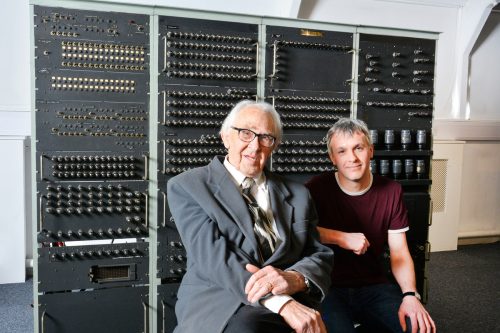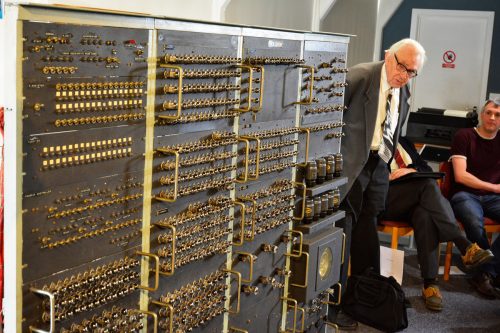Britain’s first mass-produced business computer goes on display at The National Museum of Computing
More than 60 years after it was first revealed to the public, Britain’s first mass-produced business computer, the Hollerith Electronic Computer (HEC), is now on display at The National Museum of Computing (TNMOC) on Bletchley Park.

The HEC was the prototype for the range of computers that were to become Britain’s best-selling first-generation computer and, as the first computer installed in many countries including India, New Zealand and East Africa, the machine played a key role in starting the global computer revolution.
Today, the first version of the two by three metre HEC with its highly innovative magnetic drum store can be seen by visitors to the First Generation Gallery at TNMOC where it stands alongside other machines of the period: the ongoing reconstruction of the 1949 EDSAC computer and the original 1951 Harwell Dekatron / WITCH computer.
The HEC was commissioned by the British Tabulating Machine Company (BTM). Dr Raymond Bird, a skilled and enthusiastic electronics engineer, was tasked with its development.
Dr Bird explained the development process: “BTM was one of Britain’s largest suppliers of pre-computing punch-card systems and the company realised that computing was the company’s future. BTM had been approached by Professor Andrew Booth of Birkbeck College, London, who needed input and output technologies – punch cards – for a computer he was designing. A deal was struck and I was sent to make copies of Booth’s computer design.
“Previously I had only worked with analogue technologies and I was mesmerised by seeing this digital door opening before me. It was my job to get something working. I did the things that Booth thought were trivial – I engineered it!
“Unknown to me at the time, the people working in the room next to me were the engineers who had made the wartime code-breaking Bombe machine designed by Alan Turing and deployed at Bletchley Park. In the early 1950s they were continuing to develop machines for BTM.”
By 1953, the HEC was ready to be displayed to the public and Dr Bird clearly remembers setting up for the Business Efficiency Exhibition: “We worked throughout the night at Olympia to have the HEC ready – keeping a friendly eye on our competitors, Power Samas, who were working just as hard a few stands away. They were preparing an electronic multiplier and printer, but when they saw what we had, they had fear in their eyes! Our demonstration of the noughts and crosses game was a great success in showing the potential power of computers. This was probably the first time that a computer had gone on public display in Britain.”
Dr Bird realised that it was essential to manufacture a machine that was operationally compatible with BTM’s punch card equipment and, crucially, at a price that was in line with existing pre-computing technologies. His vision was to come to pass with the HEC 2M and later the HEC 4 which sold in record-breaking quantities from 1955 to 1962. In 1959, following a business merger, BTM was renamed ICT and the HEC 4 became the ICT1200 series.
TNMOC trustee Kevin Murrell was instrumental in arranging the long-term loan of the HEC from Birmingham Museums Collection Centre, where it had been stored for many years. He said: “The HEC is a key addition to our collection of computers representing the time when Britain was at the forefront of the global computing revolution. Our skilled volunteers have been poring over the HEC to understand how it worked and to fully document it. At first we thought that we couldn’t possibly restore any of it to working order, but now some possibilities are emerging and we will be investigating those.
“Technically the HEC has some very interesting and innovative features. Instead of delay lines, it used a magnetic drum for memory. One of its legacies can be seen in many of today’s computers and in almost every smartphone – they use modifications of the Booth Multiplier algorithm, first deployed in the HEC.”
TNMOC thanks the Birmingham Museums Trust for the loan of the HEC, and Birkbeck College, the Computer Conservation Society and individuals who have helped fund the transport of the machine.
The HEC can be seen by Museum visitors in the First Generation Gallery at The National Museum of Computing on Bletchley Park whenever the Museum is fully open.
About the Hollerith Electronic Computer (HEC)

Timeline
- 1951 HEC commissioned – design team goes to Booth’s workshop in March
- 1951 runs first program later in the year
- 1953 pre-production HEC 2 exhibited at Business Efficiency Exhibition at Olympia, London in June
- 1955 first production machine (HEC 2M) delivered
- 1959 BTM merges with ICT and HEC 4 becomes ICT 1200 series
Sales
- Precise quantity unknown, but HEC 4 is thought to have sold more than 100.
Size
- 1.5 m high by 3m wide by 0.5m deep
Valves
- approximately 1,000
Memory
- Magnetic drum rotating at 3,000 rpm with 32 tracks, 16 words per track (2 Kbytes)
Speed
- Addition 32 clock pulses or about 1.25ms
Multiplication
- 640ms (max) for a 32-bit multiplier needing 32 drum accesses
Input
- Punched card reader
Output
- Printer or card punch
- The original HEC was not suitable for commerce because it did not have both a card punch and a printer – the HEC 4 had both and was therefore suitable for business.
Processor
- Accumulator and shift register.








